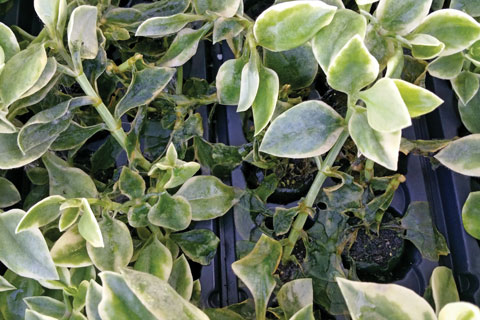11/1/2021
Preventing Disease in Propagation
Rick Yates

Many growers start crops from unrooted cuttings. High humidity and warm temperatures in propagation promote rooting, but can also promote disease. Disease progression in propagation can be swift, so it’s important to recognize and treat problems quickly and consider preventative treatments.
Pictured: Rhizoctonia Web Blight Disease on dorotheanthus.
Sanitation is the first step in preventing disease in propagation. Prior to sticking the first cutting, take time to clean and sanitize benches and irrigation systems. Remove all debris and use a chemical cleaner, such as Strip-it Pro. After cleaning, sanitize with KleenGrow, SaniDate 5.0 or ZeroTol 2.0. Never stick cuttings in reused media. If trays are reused, be sure that they’ve been properly cleaned and sanitized.
Damaged tissue is more susceptible to disease, so stick cuttings as soon as possible and hold under appropriate storage conditions when necessary. Most importantly, keep cuttings cool and moist until they’re stuck.
It’s also wise to stick the most sensitive cuttings first. Geraniums are a special case, as they’re sensitive to ethylene in shipping that can lead to substantial yellowing of the foliage. Stick geraniums first. Minimize the yellowing by spraying with Fascination at 2 ppm as soon after sticking as possible. Apply with CapSil for the best results. Avoid spraying so heavily that it runs down the stem into the soil, as that can slow rooting. Fewer yellow leaves mean less plant stress and less susceptibility to disease.
The most common diseases to cause trouble on the propagation bench include Botrytis, Phytophthora, Rhizoctonia and bacterial diseases. Empress Intrinsic, Pageant Intrinsic and Mural are good options for a preventative spray/sprench for fungal pathogens. Broadform can be used as a spray only. All of those products contain strobilurin fungicides, which have been shown to enhance rooting in many species of plants.
Stem cankers are often the result of a Botrytis/Rhizoctonia complex. Fortunately, several top choices for Botrytis also control Rhizoctonia, including the strobilurin fungicides listed above. Other Botrytis and Rhizoctonia rotation options include Affirm, Cease, Companion, Medallion, Palladium, Spirato GHN, Triathlon BA and Stargus. In propagation, a sprench or drench application over the small plants also will provide good control of stem cankers. (Broadform and Palladium can only be sprayed.)
Phytophthora is a fast-moving disease with hallmark symptoms, including bleached or necrotic tissue moving up from the stem or petiole into the leaf. Petunias are particularly susceptible to Phytophthora and should be scouted regularly to support early detection. Segovis is an outstanding Phytophthora product giving several weeks of control from a single application. It can be applied as a spray or drench. Phosphonates such as Fosphite and Phostrol are effective and also can enhance rooting. Fenstop and Segway O provide additional rotation options for Phytophthora control.
Like Phytophthora, bacterial diseases can move very quickly in propagation beds. Tell-tale signs of a bacterial infection include slimy areas on stems and/or dark, slimy leaf spots. Bacterial leaf spots caused by Xanthomonas often display a yellow halo around dark-colored centers. Bacterial infections in propagation are best treated by quickly removing symptomatic plants.
Treatments include KleenGrow, which has some curative activity, and Cease, Companion, Stargus or Triathlon BA as preventatives. Copper bactericides—such as Badge SC, Camelot O, Grotto and Phyton 35—can be helpful, especially when tank mixed with Protect DF. ZeroTol 2.0 can be used as a quick surface clean-up for bacterial ooze and for general sanitation.
Pythium isn’t typically seen in early propagation, so we don’t typically treat preventatively. If needed, Fenstop and Segway O are effective and provide good plant safety on young, tender cuttings.
It’s the responsibility of the applicator to read and follow all label directions. Labels do change without notice. Pesticides other than those listed may be safe, legal and effective. GT
Rick Yates is Technical Services Manager for GGSPro (ggsprotech@griffinmail.com).